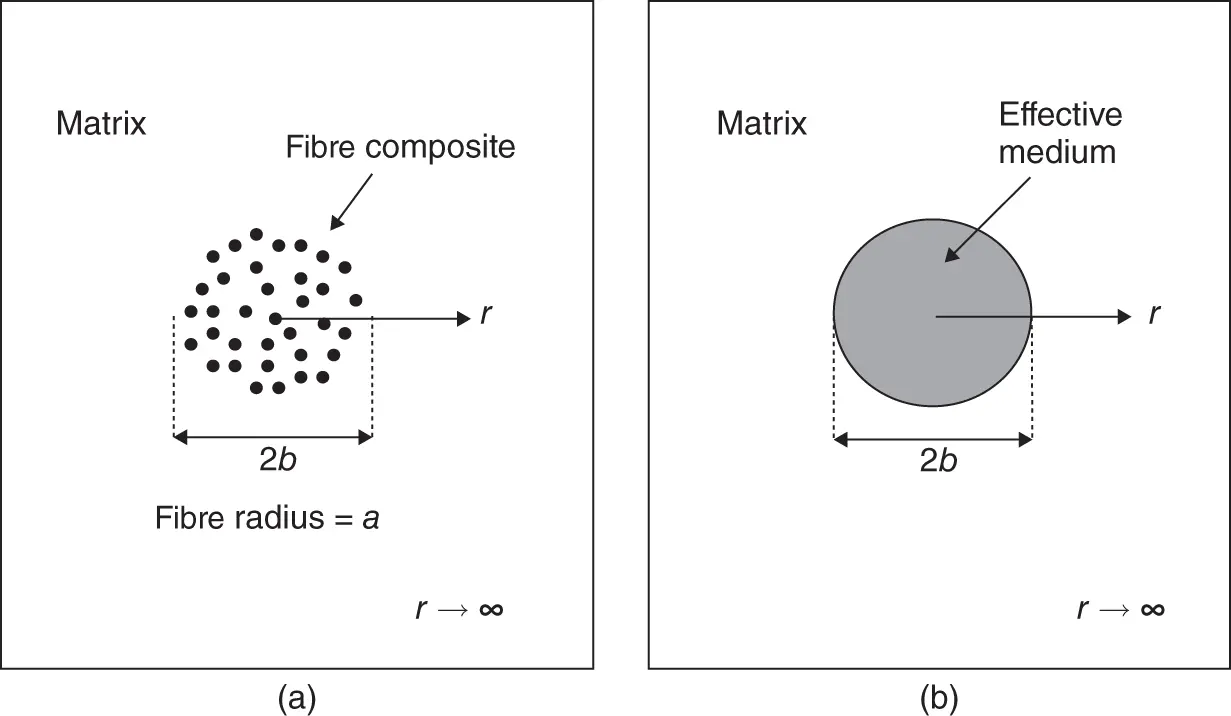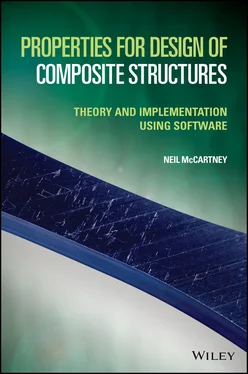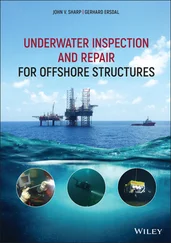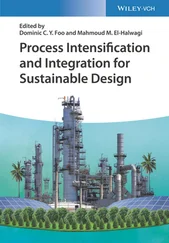A detailed study of the method used by Maxwell has revealed that his methodology can also be applied to the estimation of many other properties of fibre-reinforced composite materials that are reinforced with cylindrical fibres. The principal objective of this chapter is to show how Maxwell’s methodology can be applied to the estimation of many of the effective properties of a composite reinforced with homogeneous cylindrical fibres. The methodology of Maxwell is easily extended so that assemblies of multiphase cylindrical fibres having a range of radii and properties may be considered.
Section 4.2 provides a detailed description of Maxwell’s methodology applied to the thermal conduction problem, extending the approach to deal with multiphase cylindrical fibres having different sizes, and including the effects of thermal resistance at the fibre/matrix interfaces. It is noted that the results of Johnson and Hasselman [4] for two-phase systems having cylindrical fibres of the same size, but including interfacial thermal resistance, are in fact in error. Section 4.3 uses a radial stress and displacement formulation in conjunction with Maxwell’s methodology to estimate values for the effective properties of a fibre-reinforced composite. Sections 4.4 and 4.5 consider the method of applying Maxwell’s methodology to the estimation of the effective shear axial and transverse moduli of a fibre-reinforced composite. For each effective property, the resulting formulae for the case of just two phases, having cylindrical reinforcements of the same size, will be expressed as a mixtures estimate plus a correction term that is used to derive the conditions that determine whether the extreme values of properties are upper or lower bounds. These formulae differ in some cases from those that have been given in the literature.
4.2 General Description of Maxwell’s Methodology Applied to Thermal Conductivity
Consider an isolated cluster of parallel fibre reinforcements, embedded in an isotropic infinite matrix, as shown in Figure 4.1(a). There are N different reinforcement types such that for i = 1, …, N , there are ni cylindrical fibres of radius ai. The properties and geometry of the fibres of type i , that may differ from those of other types, are denoted by a superscript i . The cluster of all types of fibre is just enclosed by a cylinder of radius b and the parallel fibre distribution is sufficiently homogeneous for it to lead to transverse isotropic properties for the composite formed by the cluster of fibres and the matrix lying within this cylinder as shown in Figure 4.1(b). The volume fraction of fibres of type i within the cylinder of radius b is given by

Figure 4.1 (a) Discrete fibre model and (b) smoothed effective medium model of a fibre-reinforced composite embedded in infinite matrix material.
 (4.1)
(4.1)
where Vm is the corresponding volume fraction of matrix.
If there is only one type of fibre, and there are n fibres of radius a within the cylinder of radius b , then the fibre volume fraction of the composite is denoted by Vf such that
 (4.2)
(4.2)
It should be noted that by selecting all fibres to have the same properties but different sizes, composites having only a statistical distribution of fibre sizes can be considered. Similarly, by selecting all fibres to have the same size but different properties, composites having only a statistical distribution of properties can be considered. Clearly composites having statistical distributions of both size and properties can also be considered.
4.2.1 Temperature Distribution for an Isolated Fibre
It is useful to extend the methodology used by Maxwell [1] to estimate the electrical conductivity of a cluster of fibres embedded in an infinite matrix so that fibre-reinforced composites can be considered. The following description modifies the approach of Maxwell so that it applies to the analogous problem of thermal conductivity, and to a multiphase system of fibres. Hasselman and Johnson [4] considered the same problem where the fibres were all the same type size and where there is an interfacial thermal resistance between the fibers and the matrix.
Consider a single fibre of radius a embedded in an infinite matrix. A set of cylindrical polar coordinates (r,θ,z) is introduced having origin on the axis of the fibre. The temperature distribution in the fibre and surrounding matrix must satisfy Laplace’s equation, namely
 (4.3)
(4.3)
The transverse thermal conductivity of the fibre is denoted by κTf whereas the matrix is assumed isotropic having thermal conductivity κm. On the external boundary r→∞ a temperature distribution is imposed that would lead, in a homogeneous matrix material under steady-state conditions, to the following temperature distribution having a uniform gradient α
 (4.4)
(4.4)
At the fibre/matrix interface, the following boundary conditions are imposed
 (4.5)
(4.5)
The temperature distributions in the fibre and matrix, denoted by Tf and Tm, respectively, must satisfy ( 4.3) and the boundary conditions ( 4.5) so that
 (4.6)
(4.6)
 (4.7)
(4.7)
It should be noted that any temperature T0 can be added to the solution defined by ( 4.6) and ( 4.7) without affecting the satisfaction of the interface conditions ( 4.5). It should also be noted that when considering an infinite medium having a uniform temperature gradient, it is inevitable that temperatures lower than absolute zero will be encountered. This is not a matter for concern as the use of an infinite medium is simply a mathematical construct, designed to enable a specific method of estimating effective properties of the composite enclosed by the cylinder of radius b .
4.2.2 Maxwell’s Methodology for Estimating Transverse Conductivity
The first stage is to consider the perturbing effect of an isolated cluster of parallel fibres, having different sizes and properties as described in Section 4.1, in the infinite matrix at very large distances from the cluster. The transverse thermal conductivity of the fibres of type i is denoted by κTf(i). The cluster is assumed to be homogeneous regarding the distribution of fibres, and leads to an effective transverse thermal conductivity κTeff for the composite. The perturbing effect of the fibre cluster is estimated by superimposing the perturbations caused by each fibre and recognising that, at large enough distances, all the fibres in the cluster can considered as located at the origin that is situated at the centre of one of the fibres in the cluster. Thus, for the case of multiple phases, the temperature distribution ( 4.7) for the matrix is generalised to the form
Читать дальше


 (4.1)
(4.1) (4.2)
(4.2) (4.3)
(4.3) (4.4)
(4.4) (4.5)
(4.5) (4.6)
(4.6) (4.7)
(4.7)










